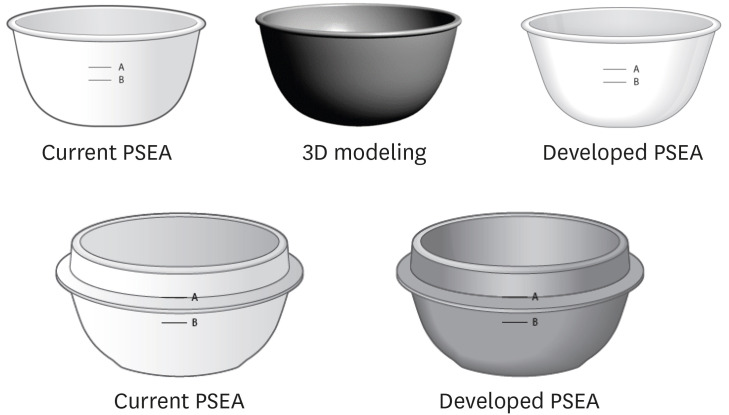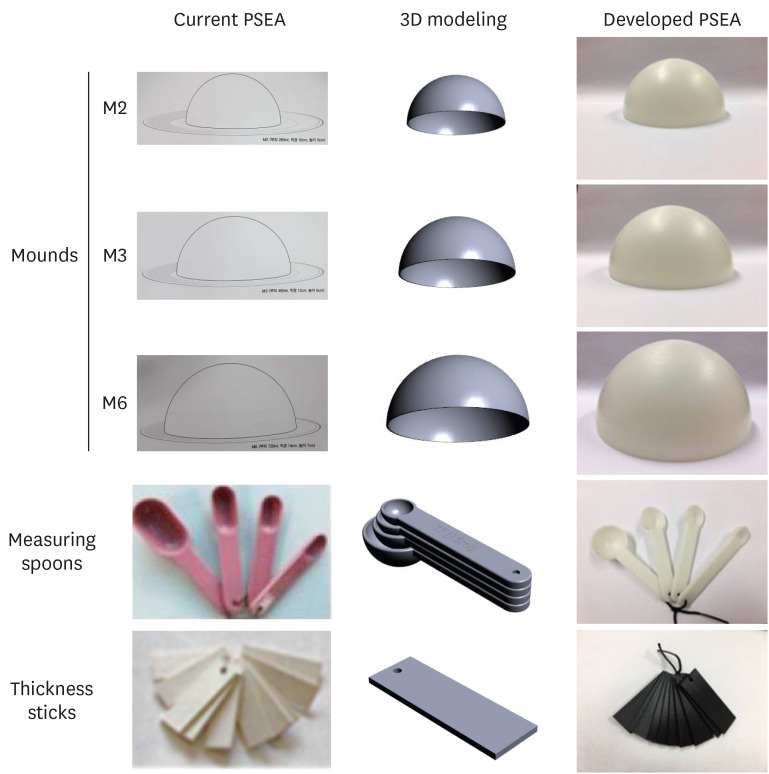Nutr Res Pract.
2020 Dec;14(6):667-678. 10.4162/nrp.2020.14.6.667.
Evaluation of portion size estimation aids for the Korea National Health and Nutrition Examination Survey
- Affiliations
-
- 1Department of Food and Nutrition, Myongji University, Yongin 17058, Korea
- 2Division of Food Science, Kongju National University, Yesan 32439, Korea
- 3Department of Food and Nutrition, Daejeon University, Daejeon 34520, Korea
- KMID: 2508798
- DOI: http://doi.org/10.4162/nrp.2020.14.6.667
Abstract
- BACKGROUND/OBJECTIVES
This study aimed to improve portion size estimation aids (PSEAs) used in the nutrition survey of the Korea National Health and Nutrition Examination Survey (KNHANES) and validate the accuracy and precision of the newly developed aids.
SUBJECTS/METHODS
We conducted intensive interviews with survey experts in KNHANES and consulted with experts to collect opinions about improvement of PSEAs. Based on the results of the interviews, 5 types of PSEAs (rice bowl, earthen pots, mounds, measuring spoons, and thickness sticks) were newly developed using 3-dimensional (3D) modeling or modification of color or shape. Validation tests were conducted with 96 adults 20 years old or older. For the rice bowl and earthen pots, the participants were asked to select the more similar PSEA in size after being shown the real dishes. For the mounds, measuring spoons, and thickness sticks, the participants were presented with actual plates of food and asked to estimate the given portion sizes using the given PSEAs.
RESULTS
The improved 2-dimensional (2D) picture aid for the rice bowl reflecting the size distortion by angle of view using 3D modeling was perceived more closely to the actual size than the current 2D picture (P < 0.001). The change of the color of 2D pictures and 3D models, the change of shape of the measuring spoons, and the 3-dimensionalization of the 2D mounds had no significant improvement in the subjects' perception.
CONCLUSIONS
The currently used 2D PSEAs need to be fully redesigned using 3D modeling to improve subjects' perception. However, change of color or shape will not be necessary. For amorphous foods, it is suggested that more evaluation be performed before reaching a final conclusion in the use of PSEAs, or alternative ways to improve accuracy of estimation need to be explored.
Keyword
Figure
Reference
-
1. Nelson M, Atkinson M, Darbyshire S. Food photography II: use of food photographs for estimating portion size and the nutrient content of meals. Br J Nutr. 1996; 76:31–49. PMID: 8774215.
Article2. Nelson M, Atkinson M, Darbyshire S. Food photography. I: the perception of food portion size from photographs. Br J Nutr. 1994; 72:649–663. PMID: 7826990.
Article3. Lucas F, Niravong M, Villeminot S, Kaaks R, Clavel-Chapelon F. Estimation of food portion size using photographs: validity, strengths, weaknesses and recommendations. J Hum Nutr Diet. 1995; 8:65–74.
Article4. Cypel YS, Guenther PM, Petot GJ. Validity of portion-size measurement aids: a review. J Am Diet Assoc. 1997; 97:289–292. PMID: 9060946.5. Robson PJ, Livingstone MB. An evaluation of food photographs as a tool for quantifying food and nutrient intakes. Public Health Nutr. 2000; 3:183–192. PMID: 10948385.
Article6. Matheson DM, Hanson KA, McDonald TE, Robinson TN. Validity of children's food portion estimates: a comparison of 2 measurement aids. Arch Pediatr Adolesc Med. 2002; 156:867–871. PMID: 12197792.7. de Vlieger NM, Weltert M, Molenaar A, McCaffrey TA, Rollo ME, Truby H, Livingstone B, Kirkpatrick SI, Boushey CJ, Kerr DA, Collins CE, Bucher T. A systematic review of recall errors associated with portion size estimation aids in children. Appetite. 2020; 147:104522. PMID: 31751634.
Article8. Ministry of Health and Welfare, Korea Centers for Disease Control and Prevention. Korea Health Statistics 2018: Korea National Health and Nutrition Examination Survey (KNHANES VII-3) [Internet]. Cheongju: Korea Centers for Disease Control and Prevention;2019. cited 2019 March 6. Available from: https://knhanes.cdc.go.kr/knhanes/main.do.9. Ministry of Health and Welfare, Korea Centers for Disease Control and Prevention. Guideline for Nutrition Survey in 6th Korea National Health and Nutrition Examination Survey. Cheongju: Korea Centers for Disease Control and Prevention;2015.10. Godwin S, McGuire B, Chambers E 4th, McDowell M, Cleveland L, Edwards-Perry E, Ingwersen L. Evaluation of portion size estimation aids used for meat in dietary surveys. Nutr Res. 2001; 21:1217–1233.
Article11. Godwin S, Chambers E 4th, Cleveland L, Ingwersen L. A new portion size estimation aid for wedge-shaped foods. J Am Diet Assoc. 2006; 106:1246–1250. PMID: 16863721.
Article12. McGuire B, Chambers E 4th, Godwin S, Brenner S. Size categories most effective for estimating portion size of muffins. J Am Diet Assoc. 2001; 101:470–472. PMID: 11320957.
Article13. Venter CS, MacIntyre UE, Vorster HH. The development and testing of a food portion photograph book for use in an African population. J Hum Nutr Diet. 2000; 13:205–218. PMID: 12383127.
Article14. Turconi G, Guarcello M, Berzolari FG, Carolei A, Bazzano R, Roggi C. An evaluation of a colour food photography atlas as a tool for quantifying food portion size in epidemiological dietary surveys. Eur J Clin Nutr. 2005; 59:923–931. PMID: 15928683.
Article15. Bernal-Orozco MF, Vizmanos-Lamotte B, Rodríguez-Rocha NP, Macedo-Ojeda G, Orozco-Valerio M, Rovillé-Sausse F, León-Estrada S, Márquez-Sandoval F, Fernández-Ballart JD. Validation of a Mexican food photograph album as a tool to visually estimate food amounts in adolescents. Br J Nutr. 2013; 109:944–952. PMID: 23021307.
Article16. Thoradeniya T, de Silva A, Arambepola C, Atukorala S, Lanerolle P. Portion size estimation aids for Asian foods. J Hum Nutr Diet. 2012; 25:497–504. PMID: 22500981.
Article17. Almiron-Roig E, Aitken A, Galloway C, Ellahi B. Dietary assessment in minority ethnic groups: a systematic review of instruments for portion-size estimation in the United Kingdom. Nutr Rev. 2017; 75:188–213. PMID: 28340101.
Article18. Yuhas JA, Bolland JE, Bolland TW. The impact of training, food type, gender, and container size on the estimation of food portion sizes. J Am Diet Assoc. 1989; 89:1473–1477. PMID: 2794306.19. Slawson DL, Eck LH. Intense practice enhances accuracy of portion size estimation of amorphous foods. J Am Diet Assoc. 1997; 97:295–297. PMID: 9060948.
Article20. Ovaskainen ML, Paturi M, Reinivuo H, Hannila ML, Sinkko H, Lehtisalo J, Pynnönen-Polari O, Männistö S. Accuracy in the estimation of food servings against the portions in food photographs. Eur J Clin Nutr. 2008; 62:674–681. PMID: 17440523.
Article21. Young LR, Nestle MS. Portion sizes in dietary assessment: issues and policy implications. Nutr Rev. 1995; 53:149–158. PMID: 7478309.
Article22. Hwang IK, Kim MR, Song HN, Moon BK, Lee SM, Seo HS. Food Quality Management and Sensory Evaluation. Paju: Kyomunsa;2014. p. 147–175.23. Chambers E 4th, Godwin SL, Vecchio FA. Cognitive strategies for reporting portion sizes using dietary recall procedures. J Am Diet Assoc. 2000; 100:891–897. PMID: 10955046.24. Meilgaard MC, Civille GV, Carr BT. Sensory Evaluation Techniques. Boca Raton (FL): CRC Press;2007. p. 435.25. Ministry of Health and Welfare, Korea Centers for Disease Control and Prevention. Korea Health Statistics 2016: Korea National Health and Nutrition Examination Survey (KNHANES VII-1). Cheongju: Korea Centers for Disease Control and Prevention;2017. p. 169.
- Full Text Links
- Actions
-
Cited
- CITED
-
- Close
- Share
- Similar articles
-
- The Current Status and the Perspectives of Nutrition Survey
- Establishment of One Portion Size of Foods Frequently Consumed by Korean Children Aged 6-11 Using 2005 Korea National Health and Nutrition Examination Survey and Its Comparison with Adults
- The Korea National Health and Nutrition Examination Survey (KNHANES): Current Status and Challenges
- Preliminary Study on the Establishment of Proper Portion Using Consumed Size and Food Preference of Frequently Served Meals in the Elementary School Lunch Program in Inchon - 2 . A Study on the Consumption Size of Frequently Served Meals in the Elementary School Lunch Program in Inchon
- Energy Content Estimation by Collegians for Portion Standardized Foods Frequently Consumed in Korea



